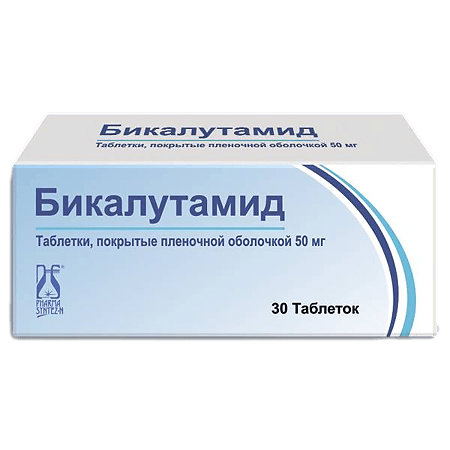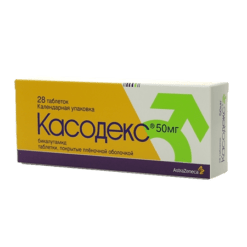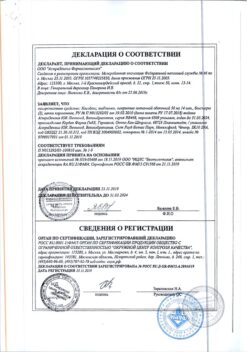No products in the cart.
Description
Pharmacotherapeutic group
Antiandrogenic antitumor drug
ATX code
L02BB03
Pharmacodynamics:
Bicalutamide is a racemic mixture with nonsteroidal anti-androgenic activity of the predominantly (R)-enantiomer with no other endocrine activity. Bicalutamide binds to androgen receptors and, without activating gene expression, suppresses the stimulating effect of androgens. This results in regression of prostate malignancies.
In some patients, discontinuation of bicalutamide can lead to the development of clinical “withdrawal” syndrome of anti-androgens.
The use of bicalutamide at a daily daily dose of 150 mg to treat patients with locally advanced (T3-T4 any N M0; T1-T2 N+ M0) prostate cancer as immediate hormonal therapy or as adjuvant therapy significantly reduces the risk of disease progression and bone metastases. In locally advanced prostate cancer there was a tendency to improve the indicators of survival without signs of disease progression in the groups of patients receiving bicalutamide at a dose of 150 mg as immediate therapy or adjuvant therapy compared to standard therapy (surgical treatment and radiation therapy).
Life expectancy has been shown to increase among patients with locally advanced prostate cancer who received bicalutamide at a dose of 150 mg as immediate monotherapy or adjuvant therapy in combination with radiation therapy.
Pharmacokinetics:
After oral administration, it is rapidly and completely absorbed from the gastrointestinal tract. Food intake does not affect absorption.
The (S)-enantiomer is eliminated from the body much faster than the (R)-enantiomer the half-life of the latter is about 7 days.
When taking bicalutamide daily, the plasma concentration of the (R)-enantiomer increases about 10-fold due to the long half-life of the latter, which makes it possible to take the drug once daily.
When bicalutamide is taken daily at a dose of 50 mg, the equilibrium plasma concentration of (R)-enantiomer is about 9 mcg/ml. When bicalutamide is administered at 150 mg daily, the equilibrium concentration of the (R)-enantiomer is approximately 22 µg/ml. At equilibrium about 99% of all circulating enantiomers in the blood is the active (R)-enantiomer.
The (R)-enantiomer pharmacokinetics are not affected by age and mild to moderate renal impairment. There is data that in patients with severe hepatic impairment the elimination of (R)-enantiomer from plasma is delayed.
The binding to plasma proteins is high (for racemic mixture 96% for (R)-enantiomer 996%). Intensively metabolized in the liver (by oxidation and formation of conjugates with glucuronic acid). Metabolites are excreted by the kidneys and intestines in approximately equal proportions.
The average concentration of the (R)-enantiomer in the semen of men receiving bicalutamide and a dose of 150 mg is 49 µg/ml.
Indications
Indications
– Bicalutamide at a dose of 50 mg in combination with a GnRH (gonadotropin-releasing hormone) analogue or surgical castration is indicated for the treatment of advanced prostate cancer.
Active ingredient
Active ingredient
Composition
Composition
1 film-coated tablet contains:
the active substance: bicalutamide 50.0 mg;
excipients: lactose monohydrate 61.0 mg, sodium carboxymethyl starch 7.5 mg, povidone 5.0 mg, magnesium stearate 1.5 mg;
tablet shell: film coating 3.8 mg.
The film coating contains: macrogol (13.33%), titanium dioxide (20.00%), hypromellose (66.67%).
How to take, the dosage
How to take, the dosage
Adult men (including elderly)
In advanced prostate cancer in combination with a GnRH analogue or surgical castration: Orally, 50 mg once daily. Treatment with Bicalutamide should be started at the same time as starting GnRH analogue or surgical castration.
In locally advanced prostate cancer: orally, 150 mg once daily. Bicalutamide should be taken long-term for at least 2 years. If there are signs of disease progression, the drug should be stopped.
Correcting the dosing regimen
Renal dysfunction
Dose adjustment is not required.
Hepatic disorders
Dose adjustment is not required in mild hepatic impairment. Patients with moderate to severe hepatic impairment may have increased cumulation of bicalutamide (see section “Special Precautions”).
Interaction
Interaction
There is no evidence of pharmacodynamic or pharmacokinetic interaction between bicalutamide and GnRH analogues.
The (R)-enantiomer of bicalutamide has been shown in in vitro studies to be an inhibitor of CYP3A4 isoenzyme and to have less effect on the activity of CYP 2C9 CYP 2C19 and CYP 2D6 isoenzymes. In clinical studies using phenazone as a marker of cytochrome P450 (CYP) activity, no potential ability of bicalutamide to interact with other drugs was found; however, when bicalutamide was used for 28 days against midazolam, the area under the concentration-time curve (AUC) of midazolam was increased by 80%.
The concomitant use of bicalutamide with drugs such as terfenadine astemizole and cisapride is contraindicated. Caution should be exercised when prescribing bicalutamide concomitantly with cyclosporine or “slow” calcium channel blockers. It may be necessary to reduce the dose of these drugs especially in case of side effects. After initiation or withdrawal of bicalutamide, close monitoring of cyclosporine plasma concentrations and clinical condition of the patient is recommended.
Persons should exercise caution when using bicalutamide concomitantly with agents that inhibit microsomal liver enzymes, such as cimetidine or ketoconazole, as their concomitant use may increase plasma concentrations of bicalutamide and potentially lead to increased incidence of side effects.
Bicalutamide potentiates the effect of indirect coumarin anticoagulants, including warfarin, because it competes with them for binding to proteins. It is recommended to monitor prothrombin time regularly when prescribing bicalutamide to patients receiving coumarin-type indirect anticoagulants.
Special Instructions
Special Instructions
In patients with disease progression with an increase in prostate-specific antigen (PSA) concentrations, discontinuation of bicalutamide treatment should be considered.
When bicalutamide is prescribed to patients receiving coumarin-type anticoagulants, regular monitoring of prothrombin time is recommended.
With the potential for inhibition of cytochrome P450 activity (CYP 3A4 isoenzyme) by bicalutamide, caution must be exercised when concomitantly prescribing bicalutamide with drugs primarily metabolized with CYP 3A4 (see “Contraindications” and “Interaction with other medicinal products”).
In patients taking GnRH agonists, a decrease in glucose tolerance has been observed. This effect can lead to the development of diabetes mellitus or decreased glucose tolerance in patients with diabetes mellitus. Therefore, patients taking bicalutamide in combination with GnRH agonists should have their blood glucose concentrations monitored.
Patients with lactose intolerance should be informed that each tablet of bicalutamide 50 mg contains 61 mg of lactose monohydrate.
The use in patients with hepatic dysfunction
Bicalutamide is extensively metabolized in the liver. Given the possibility of delayed excretion of bicalutamide and cumulation of bicalutamide in patients with impaired liver function, periodic evaluation of liver function is appropriate. Most changes in liver function occur within the first 6 months of treatment with bicalutamide.
Bicalutamide should be used with caution in patients with moderate to severe liver function impairment.
Changes in severe liver function with bicalutamide are rare (see side effects section) and deaths have been reported.
Bicalutamide should be discontinued if severe changes in liver function develop.
Precautionary measures for use
No special precautions are required when handling the drug.
Drowsiness and dizziness may occur with bicalutamide. If these adverse events occur, you should refrain from performing these activities.
Contraindications
Contraindications
– Hypersensitivity to bicalutamide or other components of the drug;
– concomitant administration with terfenadine astemizole and cisapride;
– Bicalutamide should not be administered to children and women.
– Impaired liver function;
– Lactose intolerance;
– Lactase deficiency and glucose-galactose malabsorption.
Side effects
Side effects
Bicalutamide is generally well tolerated. Only in rare cases is bicalutamide discontinued due to side effects caused by the drug. According to WHO guidelines, the side effects of bicalutamide are classified according to their frequency of use as follows: very common – â¥10% common – â¥1% and < 10% infrequent – â¥01% and < 1% rare – â¥1 001% and < 01% very common – < 001% unknown (cannot be estimated based on available data).
The following are side effects that have occurred with bicalutamide 150 mg once daily and with concomitant use of bicalutamide 50 mg once daily with GnRH analogues.
Disorders of the blood and lymphatic system
often: anemia.
Immune system disorders
infrequent: hypersensitivity reactions (including angioedema and urticaria*).
Mental disorders
often: decreased libido (sexual desire) depression.
Nervous system disorders
very often: dizziness**;
often: drowsiness headache* paresthesias* insomnia* anxiety*.
Vascular disorders
very often: hot flashes**;
often: arterial hypertension*.
Heart disorders
often: myocardial infarction (fatal cases have been reported)*;
infrequently: heart failure.
Gastrointestinal disorders
very common: abdominal pain** constipation** nausea** diarrhea*;
often: dyspepsia flatulence vomiting*.
Respiratory system disorders of the thorax and mediastinum
very often: dyspnea;
often: increased cough* pharyngitis* bronchitis* pneumonia* rhinitis*;
infrequent: interstitial lung disease (fatal cases reported) (post-marketing experience).
Hepatic and biliary tract disorders
often: transient liver changes (hepatotoxicity) including. increased “hepatic” transaminase activity jaundice increased alkaline phosphatase activity* (the described changes in liver function were rarely evaluated as serious often were transient in nature completely disappeared or decreased after discontinuation of the drug);
Rare: liver failure (causal relationship with bicalutamide administration is not reliably established) (post-marketing experience).
Skin and subcutaneous tissue disorders
very common: rash***;
frequent: alopecia hirsutism/restoration of hair growth dry skin itching increased sweating*.
Musculoskeletal and connective tissue disorders
often: bone pain* myasthenia* arthralgia* arthritis* back pain* pathological fractures*.
Renal and biliary tract disorders
very common: hematuria** nocturnal urge to urinate*;
often: urinary tract infection* rapid urination* urinary retention* urinary disorders* urinary incontinence*.
Renital and breast disorders
very common: gynecomastia (may persist even after stopping therapy, especially if the drug is taken for a long time) and breast pain;
often: impotence/ erectile dysfunction.
Endocrine system disorders
often: hyperglycemia*;
frequency unknown: decreased glucose tolerance (post-marketing experience)*.
Metabolic and nutritional disorders
very common: asthenia;
frequent: anorexia weight gain weight loss*.
General disorders and disorders at the site of administration
very often: chest pain** peripheral edema** pelvic pain* infections*;
often: flu-like syndrome*.
* These side effects were observed only when bicalutamide (50 mg once daily) was taken concomitantly with GnRH analogues.
** These side effects were observed with bicalutamide (150 mg once daily) frequently but not very frequently.
*** These side effects were observed when bicalutamide (50 mg once daily) was taken concomitantly with GnRH analogues often but not very often.
Overdose
Overdose
Pregnancy use
Pregnancy use
Similarities
Similarities
Additional information
| Weight | 0.015 kg |
|---|---|
| Shelf life | 4 years. Do not use after the expiration date on the package. |
| Conditions of storage | Store in a dry place protected from light at a temperature no higher than 30 ° C. Store out of the reach of children. |
| Manufacturer | Pharmasintez-Nord AO, Russia |
| Medication form | pills |
| Brand | Pharmasintez-Nord AO |
Other forms…
Related products
Buy Bicalutamide, 50 mg 30 pcs with delivery to USA, UK, Europe and over 120 other countries.

















